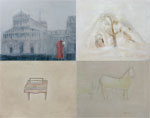A Beautiful Reason for Painting
Appreciating the Artwork of Gulistan
One piece of canvas with four sides for a border, when an artist has to face it countless times, he needs a beautiful reason for painting. He knows it is a space with some limits. When he chooses to manage the panel, he is no longer an outsider stepping into a void landscape.
The condition of freedom is to experience freedom. To experience freedom is a matter of psyche and soul. The existential individual experience, the proven skilled technique and pictures of that existence, will never replace the experience of freedom. For Gulistan, each painting is a blank starting point, an experience that has never before been encountered.
What does painting imply? This is a natural problem when viewing Gulistan’s artwork, as her work captures the existence of “significance”. Always starting from a blank point, Gulistan’s work is an encounter of “meaning”. Sometimes Gulistan creates the grounding with much seriousness, sometimes she just grabs the brush and goes. The route is not definite, like a traveler embarking on a trip for the first time, seeking to make a real footprint in an imaginative city, until the encounter happens, though sometimes it is missed.
Precisely, these paintings with an open starting point have been through a passage of “sense”, but not “feeling”. Overall, the lines and colors are often emotionally drawn with a cursive hand and an expressive one, but actually they are drawn with much awareness, judgment and keenness. Among these varied-sized panels, the encounter of the “meaning” is worth retaking; every image—the owl with head askew, the horse upon the yellowed paper with face towards us, a hand that turns a page—are images that are accidentally, but touchingly, real. Each arrival or transformation of painting will transcend into life, confirmed by the atmosphere in the painting. The so-called experiences are often vague, to be awakened, to be expected in her paintings. Gulistan has said she has more interest in these experiences that have not been expressed or come fully to the front.
Painting gives artist the power of action. You have the weapon of expression of a conqueror, but at same time you feel minute. Sometimes it is an existence of insignificance, it is just a painting. Whatever you say, whatever you do, when you consider the mystery panel unfolded, and when you neglect it, it will never become the contrary side of life. It is the unspeakable happiness that painting brings to the soul. There are no such words as brave, cruel, adorned, and no such things as unreasonable, imprecise, or unmatchable. Thus it is not hard to explain Gulistan’s will or stubbornness; she chooses to paint in white and black only for a period, discarding colors, and choosing color again for another period—for the same reason. She does not hesitate between fashionableness and old habits. She takes the criticism and opinions of others as light-hearted suggestions, and is always very ready to depart once again for the ever sensitive end of ego. At one time she chooses architecture as the theme; at another time she paints animals, still-life and flowers. One thing will be transformed into another thing, and the course of action is not necessary to remember. The style is mannerism, but painting is happiness.
Gulistan loves music, and she once was a dancer. The attribute of music is life, it is more elusive than painting; music cultivates her as a listener, and the passion of dance is continuous as the passion that once passed in front of her life, and her paintings are the matter that are left, after washing and precipitation, she seems to be happily surprised at the unsigned discovery and harvest. Even when the panels are full of colors, it must be depicted with modest words. “Sketch” is an overly fashionable word, and narrative and the subtext of the so-called “form-based modeling” is not linked with these vague images plated with the color of experience.
Gulistan’s early study of painting was also a happy experience. At elementary school, she observed the film posters pasted in the lanes of her neighborhood, and these were not works from a museum or gallery. She watched them with reverence, and redrew the pictures by memory. In this early memory, her intimate encounter with painting was about interesting photos and graphics, the memory of colors, and also about life. Many such moments slowly bring the time of life forward with the senses, the images come and go, and from a point it becomes an orbit. When we put together all these momentary points, we will see the beautiful and intertwining chords. Gulistan regards her painting as the captured voice, since vocalization makes the rhyming unit exist. The image elements progress into voice, which gives the real depicted matter a firm dimension. And more importantly, the voice of the paintings themselves is beautiful.
On my desk, there are photos of Gulistan’s works from the last couple of years. She is a diligent and fruitful painter. By selecting these pictures one by one from my favorites, I feel that I can understand more about her art. Each person will make his choice, as there is often a “serendipity” when moving from one piece of work to another, but again this seems reasonable. On the whole, the creations gradually become a unit; for a mature artist, the wholeness or associative perception is important and the real wholeness leads to the work with a difference. It relies on the fact that each piece is different, but this may be an opinion, nevertheless each option takes us to the understanding of the artist.
Ma Tian Ge
![[Gulistan's signature]](/images/gulistan_signature_small.jpg)
